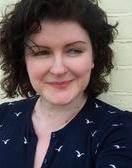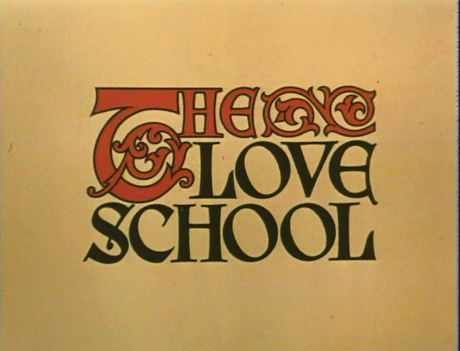
Spread over six episodes, this series traces the Pre-Raphaelite Brotherhood (or to be exact, the big three, together with Morris and Burne-Jones) from 1848 to the deaths of the protagonists...
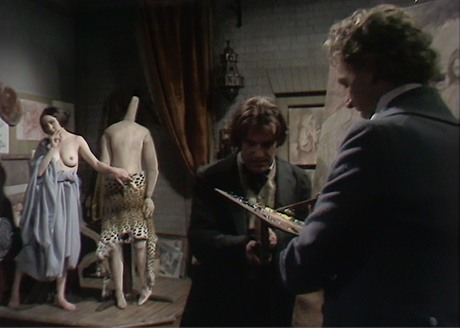
William Holman Hunt interrupts Millais while he is painting Cymon and Iphigenia
We are hastily introduced to young, handsome John Everett Millais (played by Peter Egan) and his rather clumsy, noisy best friend William Holman Hunt (played by a superb Bernard Lloyd). The closeness of the pair, their mutual excitement and enthusiasm powers us through the birth of Pre-Raphaelitism. I had forgotten how delicious young Peter Egan was. Moving on.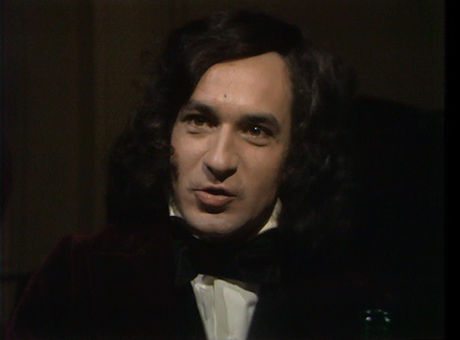
Ben Kingsley *is* Rossetti!
We meet Dante Gabriel Rossetti in the midst of his large, loud, Italian family. They are a little 'Dolmio family' but you get the idea that Dante Gabriel is a boisterous, attention-seeking baggage who is charming for the first five minutes and then is pouty and exhausting, played with insane skill by Ben Kingsley. The dinner where Holman Hunt is exposed to the Rossetti family and spaghetti is utterly delightful, and it is lovely to see a laughing, quick-talking Christina Rossetti rather than a sour old maid. It was also good to see James Collinson...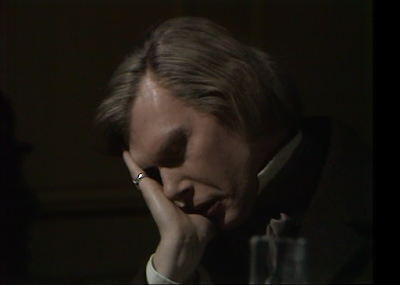
Collinson being sparkling at dinner
Yes, Christina, we would not have married him either.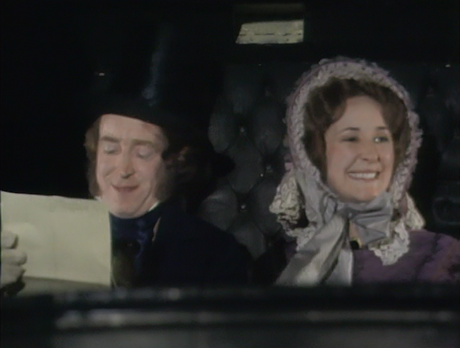
That lovely couple, the Ruskins...
Also, you'll be delighted to meet that thoroughly pleasant couple, Mr and Mrs Ruskin who have absolutely nothing amiss in their marriage. I was somewhat startled by how jolly the pair look, and how not like an elderly pervert he appeared. Well done BBC. John Ruskin (played by David Collings) is the fairy-godmother of the PRB and wonderful paintings start appearing. Enter Miss Siddal and a bath-tub...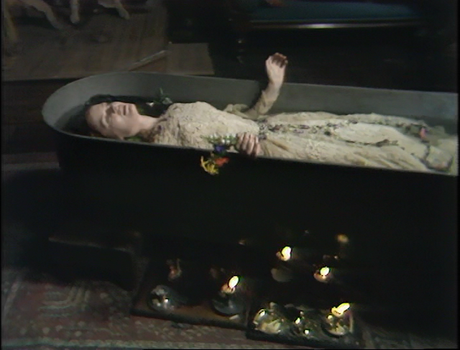
The bath-tub scene was so undramatic, but in a good way. There she is in the bathtub and we slowly notice that not all those candles are lit anymore and she is somewhat shivery. Cut to the painting and the end of the episode. I was really impressed as it seems we can't mention Miss Siddal without the words 'bath-tub' coming hot on her heels but this is not a series about the women, so there is no need to over-dramatise moments of victimhood. Hurrah! Sort of.
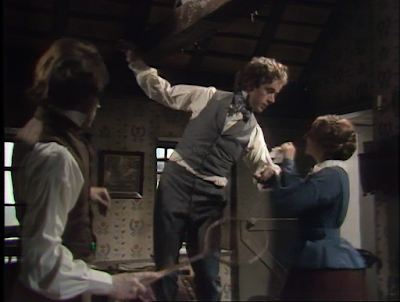
The Ruskins and their house guest on holiday...
By episode 2, 'An Impeccable Elopement', it is clear that the bonds of brotherhood have somewhat frayed. Hunt and Millais remain close but Rossetti is too busy keeping Lizzie caged up in Chatham Place painting an oddly bad portrait of her. I have to say that the quality of the art they used for the series is, by and large, astonishing, leading me to suspect that some of it is actually the real thing. This is especially true of the works in their massively intricate frames, but we'll come to that. Anyway, off goes Millais and the Ruskins to Scotland, where Millais and Ruskin play improbable badminton and the cracks in the Ruskin marriage begin to show. I appreciated that although Ruskin is ultimately the villain, there can be ascribed blame on both sides. Effie pouts at not being paid attention and Ruskin is far more excited about art than his wife. Out and about in Scotland, there are fades in and out of pictures from Millais' letters, such as...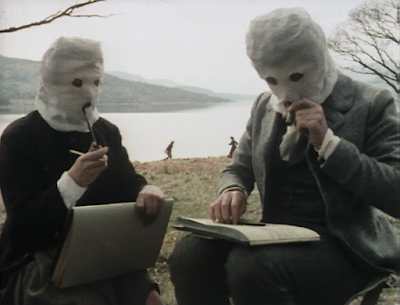
The awful midges!
...and...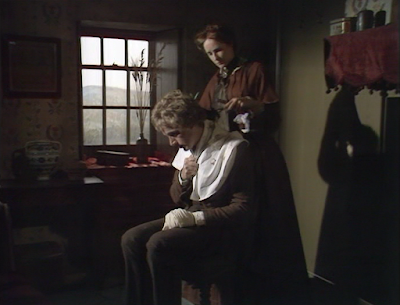
Haircut!
The sweetness of Millais and the desperation of Effie make a winning combination and by the time she's cutting his hair it's all over. Peter Egan's over-emotional artist reminds you that he is so young and inexperienced and prone to crying and so it's tempting to see him as collateral damage in the Ruskin marriage but we all know how that ends.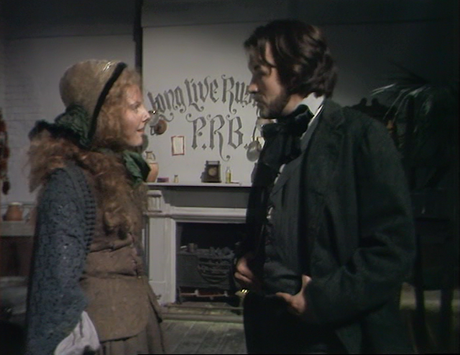
Annie Miller and William Holman Hunt
Meanwhile, back in London, living the Pre-Raphaelite dream, William Holman Hunt has discovered a stunner and is preparing to delouse her. Looking like a bag of turnips and sounding like Nancy from Oliver, Annie Miller (played by Sheila White, who actually played Nancy's best mate, Bet, in Oliver) is a challenge to Hunt's ideas of how grateful a 'rescued woman' should be. She makes him jealous and he makes her pose awkwardly as a ruined woman. He also has plans to go off to the Holy Land and leave her in the care of Hot Fred Stephens...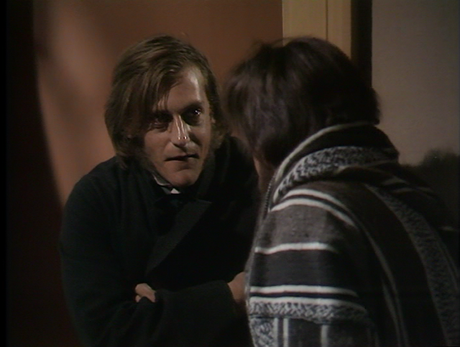
Please leave me in the care of Hot Fred Stephens
We all know how well that ended but special mention has to be made on how much David Troughton looks like F G Stephens. It is uncanny and I salute that level of care. Also, Bernard Lloyd looks really like Hunt once that beard kicked in during Episode 3, 'Seeking Bubbles'. Sheila White makes a very confrontational Annie Miller, not playing along with old Hunty at all, only as far as it suits her. You know there is no way she is going to put up with his schemes, but the pairing of her with The Scapegoat painting does make you wonder exactly why all the men rush to blame Annie when everything goes wrong.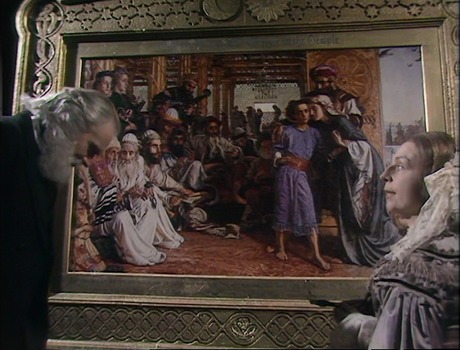
Queen Vic gets a Hunt brought to the palace for a closer look
I really need to know if they used the real paintings in the series as the frames are spectacular. I'm wondering if back in the mid-70s people would have missed the paintings from the galleries for a few weeks, rather than the production team having to notch up these masterpieces.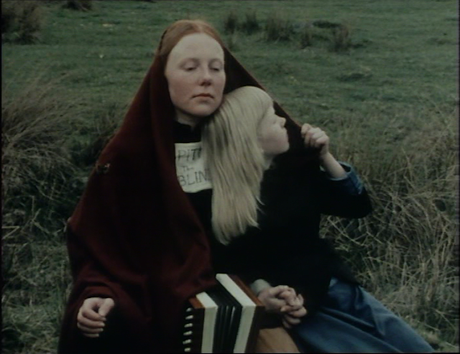
Name that painting!
Talking of the paintings, such a lot of care and love has gone into the recreations of how they were created, leading scenes like the above. Millais' outdoor painting of The Blind Girl is wonderfully imagined with impromptu rabbit shooting. The beauty of Millais' early work and the care and attention put into his conversion from 'academy' art to Pre-Raphaelite makes it deeply touching when, at the end of a long career of, dare I say, 'sloshing' for profit and a title, he has a moment of clarity in a side-room of his exhibition.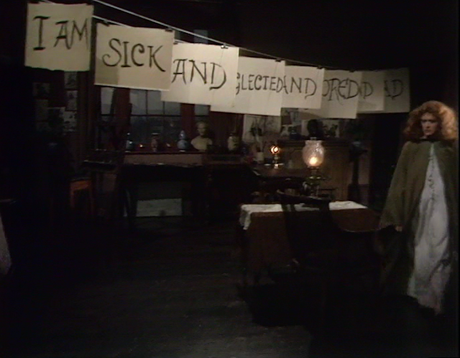
I am sick and neglected and bored and sad...
We have to wait until episode four, 'Remember Me' in order to cover Rossetti's love affair with Elizabeth. As I said, no grand drama was made out of Ophelia and so all we have is poor Lizzie stuck in the claustrophobic Chatham Place. Two things caught my attention in her miserable scenes. Firstly, the room has several red geraniums dotted about looking pathetic which immediately reminded me of this...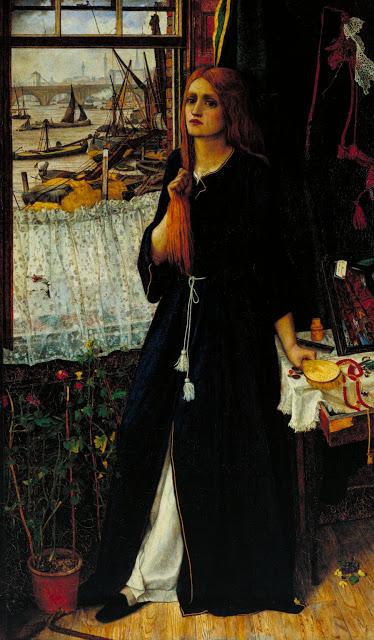
Thoughts of the Past (1859) John Roddam Spencer Stanhope
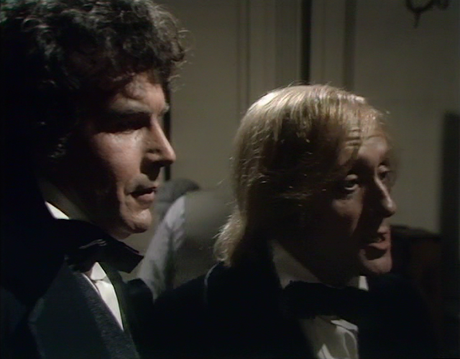
Topsy and Ned!
I think the thing that hacked people off the most in Desperate Romantics was the depiction of William Morris and Edward Burne-Jones. I was a bit nervous when Ned and Topsy bustled in to Rossetti's art class to meet their hero, but I need not have worried. David Burke as William Morris (looking oddly like a chunky Will Ferrell) and Kenneth Colley as Ned Burne-Jones start nervously and in awe but grow in confidence and charm as they find their feet as artists, husbands and fathers. The portrayal of William Morris especially made my heart sing. There was none of the bumbling cuckold, but a rounded (no pun intended) character of genius and passion, in love with his ideas, his wife and his life but with an explosive temper, quickly diffused. Instead of showing him made a fool of by Rossetti and Jane's affair, his relationship with Georgie made me raise my eyebrows a few times and it was clear that people loved him and gave you decent reasons why. The Morris marriage was not seen as the hollow, miserable sham it is often spoken of (based entirely, in my opinion, on Rossetti's vision of it through his art) but a tested marriage, with feeling as well as conflict.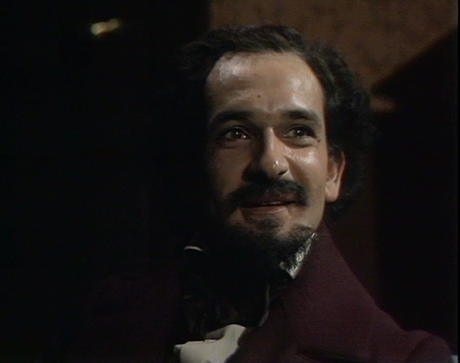
Rossetti and that look
Possibly my most favorite moment has to be something so nebulous that I swore I had imagined it the first time but it absolutely caught my breath. Having taken his band of acolytes to Oxford and presided as their king, Rossetti holds an evening of poetry at which Morris is expected to perform. Morris does so with aplomb and the fellowship of the debating chamber are there applauding and cheering for Topsy. Ben Kingsley's smile freezes then fades a little as he realises his student very much has the capacity to outshine him. It's just a look, but something in it makes you know that poor Topsy will be taken down a peg or two imminently (as he is). However, William and Jane outlast Rossetti and his influence.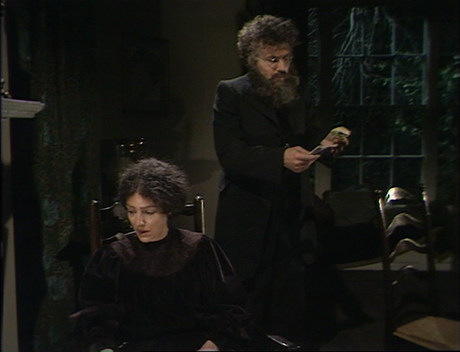
The Morrises at Home in 1882...
I was astonished at how Jane and Rossetti's story was merely a background to the Morris marriage and Jenny's health concerns. The Love School definitely make the link between Morris's temper and Jenny's (very visceral) fits which may or may not be true but definitely had a link in Morris's own imagination. The writers also brought us Political Morris and Kelmscott Press Morris, together with a very Irish George Bernard Shaw and perfect Aubrey Beardsley. It is in the depth we trace of these characters that we find their essence; in essence Morris was an idealistic, good man but Rossetti, not so much. It is Morris' death we end on, not Rossetti's. Sometimes I do feel we are told that Pre-Raphaelitism began and ended with Rossetti and my goodness me, it was such a treat to be told an alternative. Mind you, there was one thing I was definitely watching for...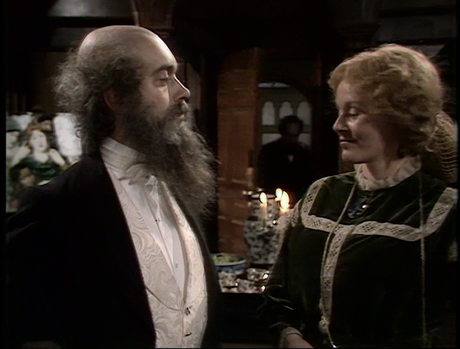
William Michael Rossetti and Fanny
Fanny! You know me, I am utterly Fanny-centric and so imagine my delight in episode 5 'Beata Beatrix' when a grief-struck Rossetti was comforted by the wonderful Elephant. Not a nut in sight! As Ben Kingsley declared, it was rather smashing to see the lovely Lumpses and her smashing bum. The beautiful April Wilding played Fanny perfectly, hovering around as Rossetti photographed Jane at Cheyne Walk and presiding over his dinner party like a disgruntled duchess.
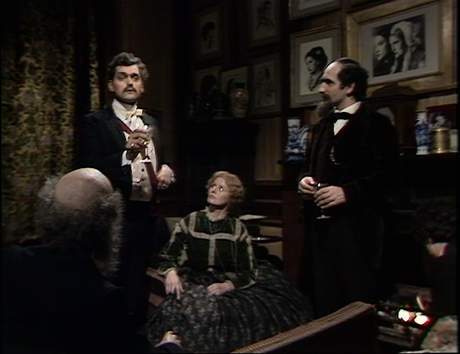
Elephant and Rhino hold a dinner party with Charlie Howell (left), but look at the wall!
Jane Morris murmurs that she is jealous of Fanny as Fanny never has to be Beatrice, some idealised dream woman. Fanny gets to be real whilst Elizabeth and Jane are merely ghosts. I obviously would have wanted more, but Wilding played her with dignity and the interactions with William Michael are awkward and tense but with an understanding that both of them are fighting over the role of nanny to a petulant, adorable, destructive child.So, what didn't I like? Well, despite using mostly the original art works, unlike Desperate Romantics's sometimes dodgy copies, we were surprised with this oddity...
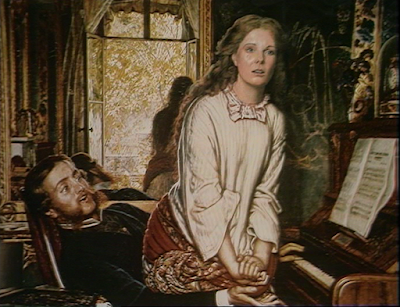
What on earth...?
Puzzling indeed. Also when Hunt was arguing with Millais over his straying from the true path of Pre-Raphaelitism in the late 1850s, it is argued that if you want to reproduce life in detail then photography is the obvious route and these are shown...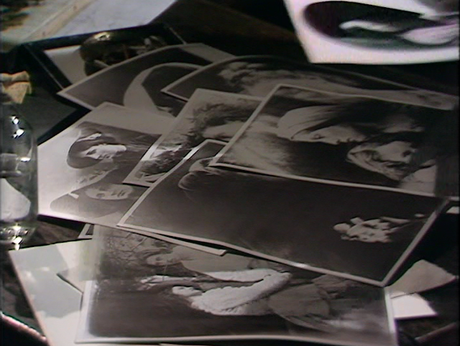
Hang on a second...
Julia Margaret Cameron! In late 1850s? Um, no, especially as some of the photos are form the 1870s but it is a reflection of the fact that Colin Ford had saved the Herschel album for the nation in 1975 and she was hot news.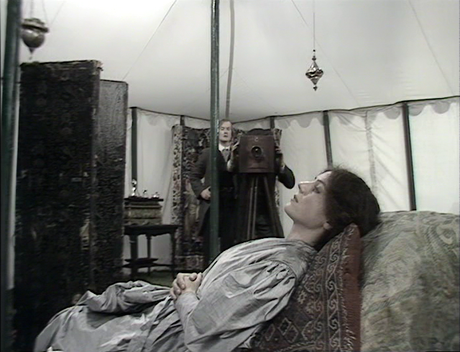
Rossetti, Jane, and those photographs
So, in conclusion I loved it. I was extremely nervous before watching it because obviously the production values are nothing like we are used to. I grew up watching 1970s and 80s BBC dramas with wobbly sets and dodgy sound and this is no exception. Another of my favorite moments is when Effie and Millais are discussing their ever-so secret love by the waterfall where her husband is posing, but the noise of the water is so great they have to bellow at the top of their lungs. All this aside, the Pre-Raphaelites are being brought to life by some top notch actors and a first-rate script. If you are looking for it there are layers and layers of double meanings and hints and references to be found. When Lizzie stood sadly by Chatham Place window, neglected, and complained all she could see was the Elephant and Castle I squealed as I took that as a reference to her knowledge of Rossetti's cheating with Fanny. The endless flashes of different pictures is quite something - were people aware of this art and The Love School just putting it in context, or did people not know it and it was a chance to say 'Look at it all!'?Either way, it was worth the wait and will be the series I turn too when I want my Pre-Raphaelites on screen. Enjoy.
